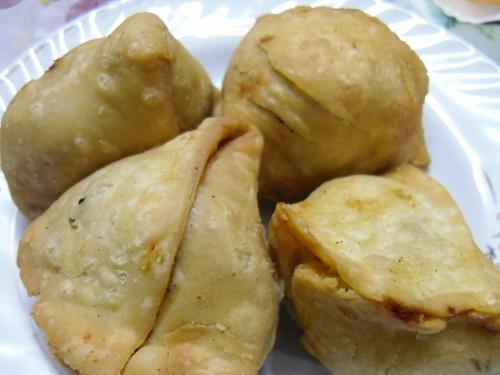 |
| Singara dough is ready for filling |
 |
| Preparation of singara/shingara |
 |
| Potatis,cauliflower,green peas,spice mix and green chillies for filling singara |
 |
| Singara/shingara before frying |
 |
| Singara/shingara frying in oil |
 |
| Singara/shingara after frying |
 |
| Singara/shingara after frying and ready to serve and eat |
 |
| Fried singara/shingara served with sos |
 |
| Singaras/shingaras
In English and other languages Singara/Shingara is referred as samosa. Even
in India
in different states singara/shingra is named and mentioned as samosa. But in
Bangladesh singra/shingra and samosa are two different snacks and fast food. Especially
Singra/Shingra dough is flaky and Samosa dough is crispy. They are different in
their shapes and tests. Singara is looks mostly like a triangular ball and samosa looks like a plain triangular. Specially to make singara/shingara potato
is a must of the ingredients.
Singara/shingara is a stuffed pastry and a popular snack in South,
Southeast,
Central
and Southwest
Asia, the Arabian Peninsula, the Mediterranean,
the Horn of
Africa, North Africa and South Africa.
It generally consists of a fried or baked triangular, pastry shell
with a savory filling, which may include spiced potatoes, onions, peas, coriander,
and lentils,
or lever of beef or chicken or lamb(kalija singara/shingara). The size and shape of a singra, as well as
the consistency of the pastry used, can vary considerably, although it is
mostly a triangular ball. Singara are often served with chutney
generally as an appetizer.
In English the word "samosa"(which is referred as singara in Bangladesh) can be traced to the
Persian
word sanbosag. The pastry name in other countries also derives from this
root, such as the crescent-shaped sanbusak or sanbusaj in Arab
countries, sambosa in Afghanistan, samosa in India, samboosa in Tajikistan,
samsa by Turkic-speaking nations, sambusa in
parts of Iran
and chamuça in Goa,
Mozambique
and Portugal.
While they are currently referred to as sambusak in the Arabic-speaking
world, Medieval Arabic recipe books sometimes spell it sambusaj.
Singara
has been a popular snack in Bangladesh
as well as in South Asia for centuries. It is believed that
it originated in Central Asia (where they are known as samsa,
prior to the 10th century. Abolfazl
Beyhaqi (995-1077), an Iranian
historian has mentioned it in his history, Tarikh-e
Beyhaghi. It was introduced to the Indian subcontinent in the 13th or 14th century
by traders from the region.
Singara was brought to
India,
where it is so famous, by Muslim traders and soldiers. Small, crisp,
mince-filled singaras were easy to make around campfires during night halts,
then conveniently packed into saddle bags as snacks for the next day’s journey.
Singara is usually
fried deep to a golden brown colour, in vegetable oil. It is served hot and is
often eaten with ketchup or chutney, such as mint, coriander
or tamarind.Usually singaras/shingaras are eaten during the tea time as a tiffin in Bangladesh.
It can also be prepared as a sweet form, rather than as a savory one. Singaras
are often served in chaat, along with the traditional accompaniments of
yogurt, chutney, chopped onions and coriander, and chaat masala.
Recipe and preparetion of Singara/Shingara :
Prep Time: 15
minutes
Cook time: 1 hour Yield: 12 Singara
Ingredients :
- 1 cup of plain flour - ½ teaspoon salt - 2 tablespoons oil - ¼ teaspoon black cumin/kali jeera (optional) - Water - 3/4 cup of sugar
Stuffing:
- 4 large boiled potatoes (peeled and diced) - 1/2 teaspoon cumin - 1 medium onion sliced - ¼ teaspoon turmeric powder - 3 green chillies chopped - Fresh coriander leaves chopped - Salt to taste - 2 tablespoons oil - Oil for deep frying
Instructions:
1. To make the dough, mix salt and water together and dissolve the salt. Then mix flour, oil and the salty water together and make smooth but a little bit hard dough. Cover the dough with cling wrap and let it set. The dough needs to sit for at least 20 minutes.
2. Heat the
frying pan and pour the oil in the pan. Add the cumin seeds and when it
crackles, add onion. When the onion is transparent, add one by one chillies,
turmeric powder, potatoes and salt to taste. Stir them until tender.
Afterwards, add the freshly chopped coriander leaves.
3. Remove the
pan from the stove and let it cool.
4. Take the
dough and knead it for 1-2 minutes and divide into 6 equal balls.
5. Roll each
dough into an oval shape (15
cm long and 12 cm wide) and cut each oval in half.
6. Take half of
oval and make a cone and seal the edges with water.
7. Fill the cone
with the potato stuffing and seal the edge with water again. It will look like
a triangle shape.
8. Repeat 12
times. You will have 12 singaras altogether.
9. Heat the
frying pan with the oil for deep fry. When oil is ready, place the singaras in
the pan few at a time. Don’t make the pan crowded. Keep space in the pan for
the singaras to float around.
10. Fry them
until crispy and brown. Serve them hot. Enjoy.
S: en.wikipedia.org; virtualbangladesh.com; banglarecipes.com.au; bn.wikipedia.org
|
No comments:
Post a Comment